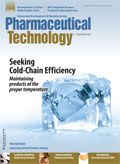Rouge Contaminants and Water Systems
Measuring the rouge corrosion rate can help determine when a system should be cleaned so the final product is not impacted
Q. Is rouge a contaminant that I need to deal with in my water system? It is visible sure, but there's no detectable impact on my water quality.

Larry Gatlin
A. Rouge is a description of corrosion deposits found in stainless-steel systems. Rouge can vary in color from a light red or orange to a dark brick. Dark purple or black colors are normally found in steam systems with varying colors due to hotter temperatures. Most often the light-red composite material of the deposits is primarily iron-hydrated oxides. Components of rouge also can include chromium, nickel, and molybdenum oxides. Rouge formation is a steady process in all metallic piping systems, but is exacerbated by high temperature and metal composition. Although, the discoloration of SS 316L piping, accessories, and vessels due to rouge deposition is not a problem in itself, any contamination of the product from the rouge is a problem. Very small amounts of metal ions can significantly impact the stability of some products.
Rouge can be placed into one of three categories:
- Class I Rouge is deposited corrosion product, consisting of iron oxides and hydroxides originating elsewhere in the system and deposited downstream. The underlying stainless-steel surface beneath such deposits usually remains unaltered. This rouge deposit can usually be easily wiped away.
- Class II Rouge is an adherent corrosion product originating in-situ on unpassivated or improperly passivated stainless-steel surfaces. By its formation, the normally passive-protective film on the stainless-steel surface is altered.
- Class III Rouge is a blue or black, mostly iron oxide corrosion product, commonly called magnetite, which forms on surfaces in high-temperature steam systems. On electropolished surfaces, corrosion deposit may be glossy black, stable, and adherent. On unpassivated mechanically polished surfaces, the corrosion deposit may be powdery black and may slough off.
Changes in the rouge-formation rate may result from operational influences of flow, points of use, pressure, oscillations in water temperatures, and supply or make-up issues. Measuring the rouge corrosion rate can help determine when a system should be cleaned so the final product is not impacted. Modern pharmaceutical water systems are completely automated, and several companies offer online instruments to measure rouge formation while maintaining adherence to 21 CFR part 11. It is the responsibility of the company to demonstrate that the measurement system works because an accurate measurement method for corrosion or rouging rate will help determine the operating limits before derouging and repassivation are required.
Historically, derouging and passivation frequencies were subjectively determined (i.e., annually, biannually, every six months, or every scheduled shutdown), but a frequency based on company risk comfort level may be too frequent thus costing the company time, resources, and money.
Larry Gatlin, PhD, is a Biotechnology & Pharmaceutical Consultant with Patheon.

Pharmaceutical Tariffs Are Imminent: How Industry is Bracing for Impact
April 16th 2025On April 14, 2025, the Trump Administration launched a national security-driven investigation into pharmaceuticals, a move that will likely result in tariffs being placed on pharmaceutical drugs, ingredients, and other components that are imported from outside of the United States.
Drug Solutions Podcast: A Closer Look at mRNA in Oncology and Vaccines
April 30th 2024In this episode fo the Drug Solutions Podcast, etherna’s vice-president of Technology and Innovation, Stefaan De Koker, discusses the merits and challenges of using mRNA as the foundation for therapeutics in oncology as well as for vaccines.